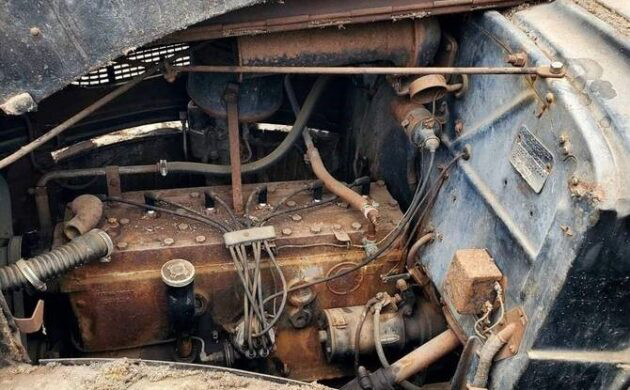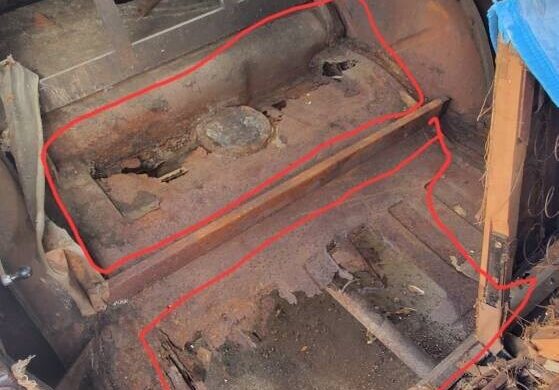50-Year Barn Find: 1936 Pontiac Master Six
Many of GM’s 1930s cars were distinguished by the number of cylinders under the hood. In 1936, Pontiac models also rode on different wheelbases but were otherwise similar except for trim. The seller took this Pontiac in on a partial trade and has decided not to restore or street rod it. Located in DeBary, Florida, this classic is available here on craigslist for $4,800 (trades also considered). Thanks for the “Poncho” tip, T.J.!
In the late 1930s, General Motors found its lineup of six brands was sometimes diluting one another. As such, GM considered letting Pontiac go, but it was LaSalle that got the axe instead in 1940. Styling changes in 1936 were subtle but noticeable to the keen eye, such as refinements to the waterfall grilles and fewer ‘silver streaks’ and thinner shells. The headlamps became longer and slimmer and were moved onto the sides of the hood. The Master Six was an entry-level product with a variety of body styles. Riding on a 112-inch wheelbase, the Master Six was powered by a 208 cubic inch inline-6 which produced 81 hp at its peak. All Pontiacs came with 4-wheel hydraulic brakes. The Master Six was the second most popular of the three series that year, accounting for a production of 44,000 units.
This Master Six is the 2-door “slant-back” model which may have appealed to those buyers on a fixed budget. The seller procured early this year when he/she sold a 1972 GTO and was willing to accept it as partial payment. In early 2022, it was dug out of a barn in Ohio where it had been living since 1972, not having seen daylight in 50 years. The odometer reading is below 55,000 miles, which the seller thinks is the actual mileage.
Why the car was parked is unknown and who can tell what it will take to get it going again. The Pontiac may be complete with most of the rust convened to the rear floorboards which are now see-through. The seller is providing replacement panels to correct that problem. Anything cloth in the interior is long gone, having become part of the diet of some small furry creatures. They apparently spared the wiring in their desire to munch on the innards of the automobile. These are machines you see seldom anymore and this one looks like an acceptable candidate to restore.
Auctions Ending Soon
 2002 Subaru Impreza WRXBid Now2 days$333
2002 Subaru Impreza WRXBid Now2 days$333
 1975 Chevrolet Corvette ConvertibleBid Now2 days$4,000
1975 Chevrolet Corvette ConvertibleBid Now2 days$4,000
 1964 Ford F-100 Camper CustomBid Now2 days$2,000
1964 Ford F-100 Camper CustomBid Now2 days$2,000
 2006 Jeep Wrangler SportBid Now4 days$11,000
2006 Jeep Wrangler SportBid Now4 days$11,000
 1974 Datsun 260ZBid Now6 days$750
1974 Datsun 260ZBid Now6 days$750





Comments
Well it’s a crusty one no doubt made even crustier with the help of Ian. The price is optimistic .
Almost 50 years ago, I was working at a Pontiac dealership when an older man had a ’32 Pontiac towed in. It hadn’t run for over 20 years. None of the mechanics wanted to work on it except for my buddy, who had restored a ’55 Caddy. In ’32, Pontiac used a flathead with two heads and the distributor poking out of the center of the block. My buddy had to rebuild a lot of parts, but he got it running.
Does anyone know when Pontiac changed the engine style?
When I get an older car to play with, and I don’t want to do the heavy lifting, I look for a shop that has an ‘old guy’. The younger ones may work, tho under his tutelage.
Gil I never new Pontiac had a V8 in1932 as you described so I looked it up and sure enough they did have a Oakland V8 for about three months in 1932. Here’s the link https://www.hemmings.com/stories/article/1932-pontiac-model-302 and some of the info about the model – ’32 models were rolling out, and consumers were shown the new Pontiac 302-series of V-8 powered cars, which rode on the former Oakland’s 117-inch wheelbase, though displaying new coachwork that maintained the outward cues. The V-8 engine itself, mostly an Oakland carryover, featured a 3 7/16 x 3 3/8 bore and stroke making 251-cu.in. and 5.2:1 compression, using a one-barrel Marvel carburetor for a rating of 85hp. It was unusual in that it utilized a 180-degree, “flat-plane” crankshaft, rather than the 90-degree “cross-plane” design used by Ford and Cadillac; the resulting vibrations were quelled using a block-mounted “vibration suppression synchronizer” that pushed against the engine rhythmically to oppose its rocking motion.
Pontiac also featured new three-speed transmissions with synchronized second and high gears and a “freewheeling” device that enabled coasting when the throttle was released without depressing the clutch. For 1932, Pontiac offered Ride Control: driver-adjustable hydraulic shock absorbers, operated via a knob on the dash that altered internal valving.
But the ’32 Pontiacs would soon prove to be short-lived; the series 302 models were in production for only three months. When the ’33 Pontiacs debuted, eight-cylinder models boasted of an all-new straight-eight engine, now enveloped in new coachwork that borrowed many elements from the Chevrolet line. These new Pontiacs continued the trend of positive sales, but history was made with the unique ’32 and its V-8 engine.
I’m sorry Bobdog; I left out the “6” in my comment. The ’32 my buddy worked on had a flathead six, but it had two separate heads, one for each pair of three cylinders, with the distributor sticking out of the center of the block.
Gil: I learned something anyway !
Actually it was Oakland that was discontinued because of Pontiac . Pontiac was Oaklands low priced brand, but Pontiac quickly out sold Oakland and the decision was to axe Oakland in 1931 . Lasalle was Cadillac’s low priced brand that didnt sell as well as Cadillac and was axed in 1940
I was going to say oh Hell no because it was in Florida and the humidity there but the listing states it was pulled from a barn in Ohio recently I’ve never been there so don’t know what the humidity is like if any. The price isn’t ridiculous someone can have a lot of fun with it
Was just today talking with a friend about how Ohio is one of the worst states for rust buckets.
Ohio, yep; salt on the roads
Attractive car and a hope complete to be restored!
Looking for a similar object: Nash Ambassador Six 1937 in complete and (running) condition. Who can help?
What on earth happened to that grille?
Troy , it’s not the humidity, it’s the salt ! This is a parts car maybe. Not worth the effort or money. Look around for a driver if this is the type you want.
I thought I had seen every grill made on an American car. So I thought. Never saw this one and not really in love with its’ style. But cool slant back car.
Greg,
The center of the grill is incorrect. It should be a continuation of the ribbed center section of the hood. Someone has cut out the original vertical ribs and put in that terrible looking grill section that looks like it came from a home appliance!
I looked up what it should look like and its kinda striking. I don’t think I’ve ever seen a car with a grill that runs up the hoodline (i that a word?), but there’s been a ton of cars made over two of my lifetimes now.
https://forums.aaca.org/gallery/image/11657-1936-pontiac-master-six-business-coupe/
Where’s a person gonna find a 1936 Pontiac grill – it might be challenging.
Fireballr,
Pontiac was the most common automobile to feature the ribbed “waterfall” type grill. It was introduced with the 1935 Pontiacs, and the ribbing continued as a central part of the hood thru 1954. In 1955 it was split into 2 narrower ribbed sections, effectively dividing the hood into 3 painted sections.